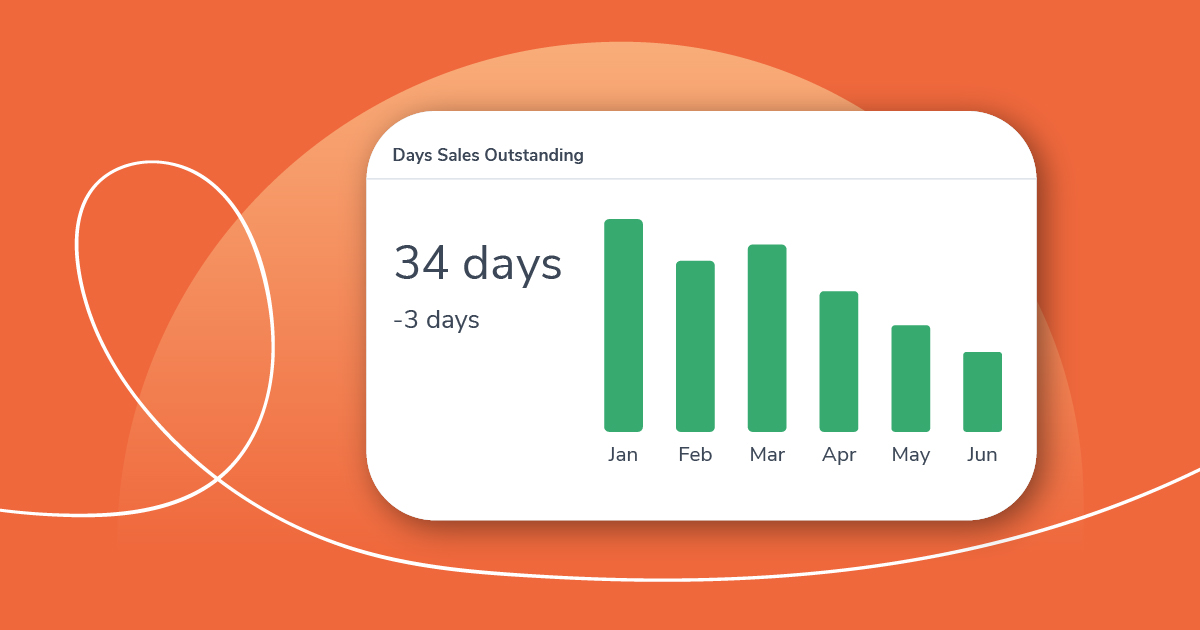Managing cash flow is crucial for any business, regardless of size or industry. One of the key factors that can impact your business’s cash flow is the time it takes for your customers to pay for the goods or services you’ve provided. That’s where Days Sales Outstanding (DSO) comes into play.
Days Sales Outstanding is a financial metric that measures the average number of days it takes for your business to collect payment from your customers after a sale is made.
It is an important metric to track as it can help your businesses understand how quickly you’re able to convert sales into cash, which is critical to maintaining a healthy cash flow. However, calculating Days Sales Outstanding manually can be a time-consuming and error-prone process.
Not anymore… With the new Days Sales Outstanding graph in Chaser, you can now quickly see, month over month, how many days, on average, your customers take to pay their invoices after a sale is made. In addition, the graph will show you your current Days Sales Outstanding and your trend over the previous 6 months.
This will not only save you time but also help your business make a more informed decision about your credit control policies and payment collections strategies.
If you use Chaser, view the Help Centre article on Days Sales Outstanding to learn more about how it’s set up in Chaser and what the calculation takes into account.
Why is it important to track your Days Sales Outstanding?
Days Sales Outstanding is an essential financial metric for businesses because it’s a good indicator of a company’s financial health and reveals the effectiveness of its ability to collect payments from its customers.
Below are some of the main reasons why your business should measure your Days Sales Outstanding month over month:
Identify trends in customer payment behaviour
By measuring your Days Sales Outstanding regularly, you can identify patterns in how quickly or slowly your customers are paying their invoices. This can be particularly important for detecting any issues early on and taking proactive steps to address them. For example, if you notice a trend of slower payments from customers, you may want to investigate further to understand why this is happening. It could be an indication of your invoicing and collection process not being as effective as it can be, or a sign of dissatisfaction with your products or services. In either case, taking action to address the issue promptly can help to prevent it from becoming a larger problem down the line.
Improve cash flow management
Measuring your Days Sales Outstanding can help you optimise your collections process and improve your cash flow. By monitoring your Days Sales Outstanding month over month, you can identify any areas where you need to take action to speed up payments and reduce outstanding balances - thus, increasing cash inflows.
Benchmark against industry averages
Thirdly, it can help you compare your business's performance against industry averages and identify areas where you may be falling behind. This can help you set realistic targets for reducing Days Sales Outstanding and improving your financial health.
Optimise credit control policies
Lastly, measuring your Days Sales Outstanding can help you evaluate the effectiveness of your payment collection process and credit control policies and adjust them as needed. For example, if you notice that your Days Sales Outstanding is high and your customers are consistently paying late, you may need to tighten your credit terms or take more aggressive steps to collect overdue payments. If you need assistance with improving your credit control policy, Chaser’s credit control experts have created a free, credit control template you can download today.
What is a good Days Sales Outstanding?
The ideal Days Sales Outstanding varies by industry, but in general, a Days Sales Outstanding of 45 days or less is considered good. It means the company is collecting payments quickly, which helps its cash flow.
But if a company's Days Sales Outstanding is 45 days or more, it's considered poor. This means the company is taking too long to collect payments, which can hurt its cash flow and make it harder to pay bills on time.
So, keep an eye on your Days Sales Outstanding and aim for a low number to keep your cash flow healthy.
How to improve your business’s Days Sales Outstanding
There are several steps you can take to reduce your Days Sales Outstanding and ultimately improve your cash flow. Here are some key strategies:
Evaluate and adjust your credit terms
Evaluating and adjusting your credit terms is a strategic step that you can take to manage your cash flow and reduce your Days Sales Outstanding (DSO). Your credit terms determine the amount of time that your customer has to pay an invoice, and your business can adjust these terms to incentivise quicker payment.
By shortening your credit terms, you can effectively reduce your Days Sales Outstanding, as customers will be required to pay their invoices sooner. Shorter payment terms can also help you improve cash flow, reduce the risk of bad debt, and allow you to reinvest funds in growth initiatives.
When evaluating credit terms, you should also consider factors such as industry norms, customer expectations, and your own financial needs. It's important to strike a balance between providing your customers with reasonable payment terms and ensuring that the business has the cash flow necessary to operate effectively.
Automate your credit control processes
Automating your credit control processes can help your company streamline its accounts receivables and payment collection process. By investing in technology such as accounts receivable automation software, like Chaser, you can improve the efficiency of your collection efforts, reduce the risk of errors, and improve your cash flow.
Chaser’s accounts receivable automation software sends personalised, automated email and SMS payment reminders to your customers, before an invoice is due and when it has become overdue, prompting them to pay. By using Chaser’s payment portal, you can increase your chances of getting paid by offering your customers all the information needed to make payments and giving them access to multiple payment methods.
By automating your accounts receivable process, you can reduce the amount of manual labour involved in chasing payments, freeing up time and resources to focus on other areas of your business. This can help improve productivity and allow you to pursue growth opportunities without being held back by late payments.
Overall, automating your accounts receivable process is a strategic investment for businesses looking to streamline their collections processes, reduce the risk of errors, and improve their cash flow.
Regularly conduct credit checks
Regularly conducting credit checks on new and existing customers is a proactive step that you should take to mitigate the risk of delayed or non-payment. Credit checks provide insight into the financial health and creditworthiness of your customer, allowing you to make informed decisions about whether to extend credit terms and how much credit to give.
By screening new, potential customers for creditworthiness, you can identify high-risk companies that may be more likely to default on payments. This can help you be proactive, and in some cases even avoid doing business with companies who may experience serious financial issues and not be in a position to pay you for the work or goods you deliver.
However, it's important to note that credit checks should be conducted regularly, as a customer's financial situation can change over time. For example, a customer who was once considered low-risk may experience financial difficulties and become a higher risk for delayed or non-payment.
By regularly monitoring the creditworthiness of customers, businesses can stay informed about changes in their financial status and adjust their credit terms accordingly.
Implement late payment fees
Implementing late payment fees can be an important step for businesses that struggle with late payments and want to ensure timely payments and maintain a healthy cash flow. The late payment fee is a fixed amount of money that is charged to the customer for each day that the bill is late.
The rate on these late payments should be clearly communicated to customers in advance, and the charges should be applied consistently across all customers who make late payments. This can help incentivize customers to pay on time and compensate the company for the costs and risks associated with delayed payments.
When developing a late payment policy, it's important to strike a balance between encouraging timely payments and maintaining positive relationships with customers. The policy should be communicated clearly and transparently to customers, and the consequences of late payments should be reasonable and fair. Overall, implementing late payment fees can help businesses manage cash flow effectively and reduce the impact of late payments on their financial health.
Another option is to suspend credit facilities for customers who consistently make late payments. This means that the customer will not be able to purchase additional goods or services until their account is up to date. Suspending credit facilities can be an effective way to encourage customers to pay on time and avoid accruing interest charges.
In conclusion, taking steps to reduce your Days Sales Outstanding can help improve your cash flow and ultimately keep your business running smoothly. By evaluating and adjusting your credit terms, automating your credit control processes, conducting regular credit checks, offering discounts for early payment, and implementing clear late payment policies, you can effectively reduce your Days Sales Outstanding and improve your bottom line.
.jpeg)



